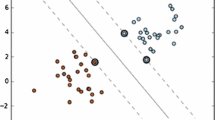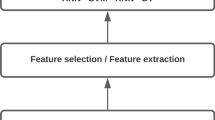Abstract
One-vs-One (OVO) and One-vs-All (OVA) are decomposition methods for multi-class strategies used to allow binary Support-Vector Machines (SVM) to transform a given k-class problem into pairwise small problems. In this context, the present work proposes the analysis of these two decomposition methods applied to the hand posture recognition problem in which the sEMG data of eight participants were collected by means of an 8-channel armband bracelet located on the forearm. Linear, Polynomial and Radial Basis Function kernels functions and its adjustments level were implemented combined to the strategies OVO and OVA to compare the performance of the SVM when mapping posture data into the classification spaces spanned by the studied kernels. Acquired sEMG signals were segmented considering 0.16 s e 0.32 s time windows. Root Mean Square (RMS) feature was extracted from each time window of each posture and used for SVM training. The present work focused in investigating the relationship between the multi-class strategies combined to kernels adjustments levels and SVM classification performance. Promising results were observed using OVA strategy which presents a reduced number of binary SVM implementation achieved a mean accuracy of 97.63%.








Similar content being viewed by others
References
Akbani R, Kwek S, Japkowicz N. Applying support vector machines to imbalanced datasets. In: European conference on machine learning. New York: Springer; 2004. pp. 39–50.
Amirabdollahian F, Walters ML. Application of support vector machines in detecting hand grasp gestures using a commercially off the shelf wireless myoelectric armband. In: 2017 international conference on rehabilitation robotics (ICORR), 2017. pp. 111–15. https://doi.org/10.1109/ICORR.2017.8009231.
Anguita D, Ghio A, Oneto L, Parra X, Reyes-Ortiz JL. Human activity recognition on smartphones using a multiclass hardware-friendly support vector machine. In: International workshop on ambient assisted living. New York: Springer; 2012. pp. 216–23.
Anguita D, Ghio A, Oneto L, Llanas Parra FX, Reyes Ortiz JL. Energy efficient smartphone-based activity recognition using fixed-point arithmetic. J Univ Comput Sci. 2013;19(9):1295–314.
Benatti S, Casamassima F, Milosevic B, Farella E, Schönle P, Fateh S, Burger T, Huang Q, Benini L. A versatile embedded platform for emg acquisition and gesture recognition. IEEE Trans Biomed Circuits Syst. 2015;9(5):620–30.
Elgohary S, Eldawlatly S, Khalil MI. Epileptic seizure prediction using zero-crossings analysis of EEG wavelet detail coefficients. In: 2016 IEEE conference on computational intelligence in bioinformatics and computational biology (CIBCB), 2016; pp. 1–6. https://doi.org/10.1109/CIBCB.2016.7758115.
Helena Burger CM, Maver Tomaz. Partial hand amputation and work. Disabil Rehabil. 2007;29(17):1317–21.
Hsu CW, Lin CJ. A comparison of methods for multiclass support vector machines. IEEE Trans Neural Netw. 2002;13(2):415–25.
Hu X, Kan J, Li W. Classification of surface electromyogram signals based on directed acyclic graphs and support vector machines. Turk J Electr Eng Comput Sci. 2018;26(2):732–42.
Huang H, Li T, Bruschini C, Enz C, Koch VM, Justiz J, Antfolk C. EMG pattern recognition using decomposition techniques for constructing multiclass classifiers. In: 2016 6th IEEE international conference on biomedical robotics and biomechatronics (BioRob), IEEE, 2016; pp. 1296–301
Ince T, Kiranyaz S, Gabbouj M. A generic and robust system for automated patient-specific classification of ecg signals. IEEE Trans Biomed Eng. 2009;56(5):1415–26. https://doi.org/10.1109/TBME.2009.2013934.
Khushaba RN, Kodagoda S. Electromyogram (EMG) feature reduction using mutual components analysis for multifunction prosthetic fingers control. In: 2012 12th international conference on control automation robotics vision (ICARCV), 2012; pp. 1534–39. https://doi.org/10.1109/ICARCV.2012.6485374.
Li Z, Hayashibe M, Fattal C, Guiraud D. Muscle fatigue tracking with evoked emg via recurrent neural network: toward personalized neuroprostheti. IEEE Comput Intell Mag. 2014;9(2):38–46. https://doi.org/10.1109/MCI.2014.2307224.
Mendez I, Hansen BW, Grabow CM, Smedegaard EJL, Skogberg NB, Uth XJ, Bruhn A, Geng B, Kamavuako EN. Evaluation of the myo armband for the classification of hand motions. In: 2017 international conference on rehabilitation robotics (ICORR), IEEE, 2017; pp. 1211–14
Ozdemir N, Yildirim E. Patient specific seizure prediction system using Hilbert spectrum and Bayesian networks classifiers. In: Computational and mathematical methods in medicine; 2014.
Pambudi MR, Sigit R, Harsono T. The bionic hand movement using myo sensor and neural networks. In: 2016 international conference on knowledge creation and intelligent computing (KCIC), 2016; pp. 259–64, https://doi.org/10.1109/KCIC.2016.7883656.
Patle A, Chouhan DS. Svm kernel functions for classification. In: 2013 international conference on advances in technology and engineering (ICATE), IEEE, 2013; pp. 1–9
Peixoto AM, Zimpel SA, de Oliveira ACA, Monteiro RLS, Carneiro TKG. Prevalência de amputações de membros superiores e inferiores no estado de alagoas atendidos pelo sus entre 2008 e 2015. Fisioterapia e Pesquisa. 2017;24(4):378–84.
Angkoon P, Chusak L, Pornchai P. Anovel feature extraction for robust EMG pattern recognition. In:arXiv preprint arXiv:0912.3973; 2009.
Platt J, et al. Probabilistic outputs for support vector machines and comparisons to regularized likelihood methods. Adv Large Margin Classif. 1999;10(3):61–74.
Reaz MBI, Hussain MS, Mohd-Yasin F. Techniques of emg signal analysis: detection, processing, classification and applications. Biol Proced Online. 2006;8(1):11–35. https://doi.org/10.1251/bpo115.
Rosales-Perez A, Garcia S, Terashima-Marin H, Coello CAC, Herrera F. Mc2esvm: multiclass classification based on cooperative evolution of support vector machines. IEEE Comput Intell Mag. 2018;13(2):18–29.
Wu YC, Lee YS, Yang JC. Robust and efficient multiclass svm models for phrase pattern recognition. Pattern Recognit. 2008;41(9):2874–89. https://doi.org/10.1016/j.patcog.2008.02.010.
Acknowledgements
The authors acknowledge the support of the Instituto Tecnológico de Aeronáutica (ITA) / Departamento de Engenharia Eletrônica e de Computação, São José dos Campos - SP, Brazil and the Laboratório de Controle Aplicado (LCA) of the Instituto Federal de Educação, Ciência e Tecnologia de São Paulo (IFSP), São Paulo - SP, Brazil. The authors thank the CAPES for the support as well.
Funding
This work was supported by the Brazilian Coordenação de Aperfeiçoamento de Pessoal de Nível Superior.
Author information
Authors and Affiliations
Corresponding author
Ethics declarations
Conflict of interest
The authors confirm that there are no known conflict of interest associated with this publication and there has been no financial support for this work that could have influenced its outcome.
Ethical standards
All procedures performed in studies involving human participants were in accordance with the ethical standards of the institutional and/or national research committee and with the 1964 Helsinki declaration and its later amendments or comparable ethical standards. Experiments were performed after approval from research ethics committee of Instituto Federal de Educação, Ciência e Tecnologia de São Paulo under the CAAE Registration Number: 80304417.4.0000.5473.
Additional information
Publisher's Note
Springer Nature remains neutral with regard to jurisdictional claims in published maps and institutional affiliations.
Rights and permissions
About this article
Cite this article
Falcari, T., Saotome, O., Pires, R. et al. Evaluation of multi-class support-vector machines strategies and kernel adjustment levels in hand posture recognition by analyzing sEMG signals acquired from a wearable device. Biomed. Eng. Lett. 10, 275–284 (2020). https://doi.org/10.1007/s13534-019-00141-9
Received:
Revised:
Accepted:
Published:
Issue Date:
DOI: https://doi.org/10.1007/s13534-019-00141-9




